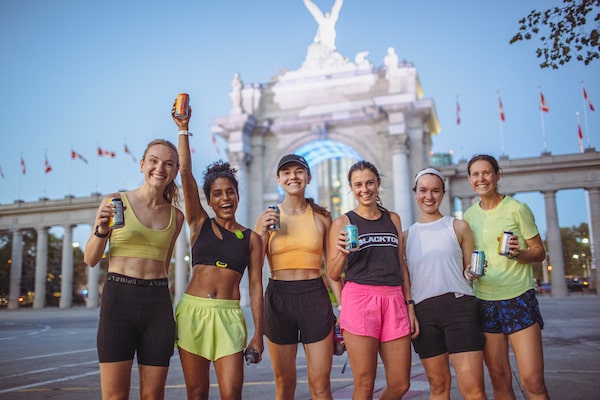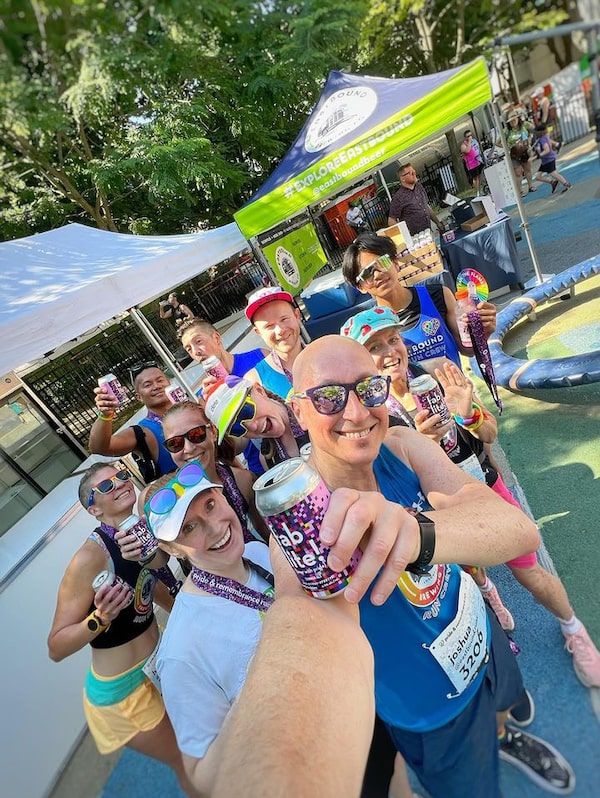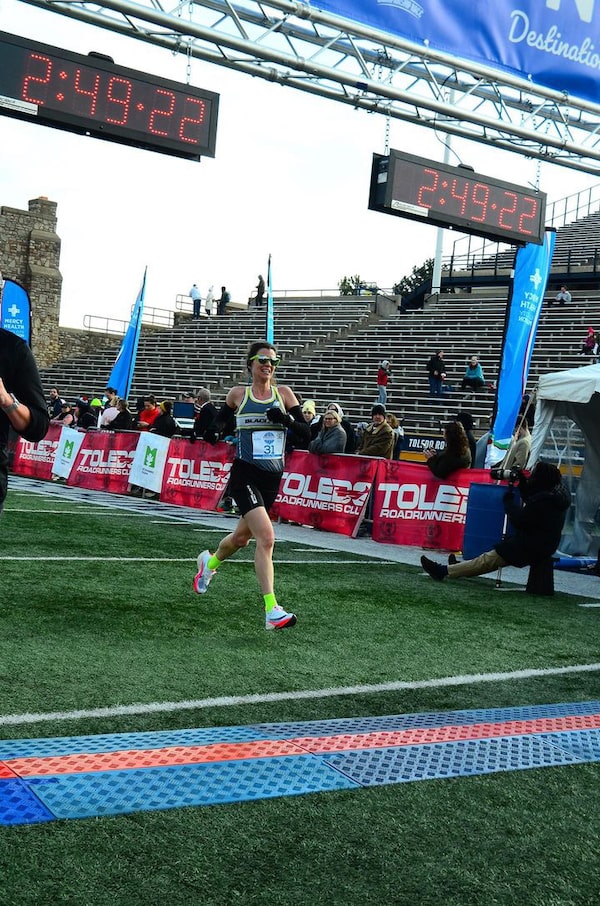
Members of the KW Run Club Black Toe running group in Toronto enjoy cans of iRun and Athletic Brewing.CARLOS OSORIO/Supplied
When Franz Xaver Kugler opened a little tavern in his small town of Deisenhofen, in southern Germany, in the early 20th century, he probably did not expect his main clientele to be endurance athletes. But his humble watering hole sat alongside a popular trail at the height of Europe’s cycling boom. Legend has it that, on a hot summer day in 1922, a swarm of 13,000 cyclists stopped in for a beer. To keep up, the improvising innkeeper had no choice but to dilute his liquor supply with lemon soda and serve his clients a new invention he called the “cyclist litre” – in German: radlermass.
In the hundred years since, booze and sport have remained joined at the hip. Key sporting moments – from wobbly Stanley Cup parades with inebriated players giving slurred speeches on national television, to Canadian skeleton athlete Jon Montgomery’s viral gulp of a pitcher of beer after winning gold at the 2010 Vancouver Olympics – have embedded alcohol into athletic culture and normalized the concept of the postworkout beverage. But as evidence of the negative health effects of liquor crystallizes, high-level athletes, weekend warriors and many in between are reconsidering how much they should drink.
Natalie MacLean talks ‘wine mom’ culture, sexist marketing and how to cut back without going sober
“We are living through a cultural moment of greater social discourse about health and well-being,” said Peter Butt, an addiction expert and one of the authors of Canada’s Guidance on Alcohol and Health. The 2023 report commissioned by Health Canada indicates that any drinking at all can be detrimental to one’s health and suggests capping drinks at two a week, significantly lower than the previous limits of 15 for men and 10 for women.
Inside the realm of elite athletics, the consequences of hitting the bottle are well established. Alcohol’s ability to disrupt sleep, reduce concentration and deliver empty calories is why some athletes in the pursuit of record-setting achievements – such as the twice-defending Olympic marathon champion, Eliud Kipchoge – do not drink at all. But those health drawbacks have apparently not deterred non-Olympic fitness buffs from enjoying beer and spirits even more than the general population. A 2022 American study of more 38,000 participants found that moderately to highly fit people were more likely to be moderate and heavy drinkers than sedentary people. Researchers attributed this link to avid exercisers having a penchant for sensation-seeking, whether that’s the challenge of a tough workout or the pleasant buzz of a few pints. Then, there is the “licensing effect,” the idea that doing something good affords one the privilege of indulging in something bad.
Athletic Brewery, founded in Founded in Stratford, Conn., in 2017, is considered the largest non-alcoholic brewery in the world.Carlos Osorio/Supplied
Kathleen Lawrence, a 39-year-old occupational therapist and runner from Toronto, developed a habit of enjoying a few drinks every Friday over the past decade.
“I would tell myself: If I work hard in training or run a big race, I deserve this beer.”
Her ritual did not prevent her from completing a marathon in two hours and 49 minutes, which makes her a contender for the top 10 in any marathon in the country. But in the past year, Lawrence has cut her alcohol intake in half. She attributes it to more awareness about the negative effects of the substance, but also to the rising availability of quality, non-alcoholic options. Her running group, BlackToe Running, often has postrun socials at restaurants or bars. In previous years, a beer after her workout was the staple. Now, it’s just as common for her and her friends to socialize over a mocktail.
The demand for health-tracking tech is booming. But does it actually help us?
“There is still a culture of meeting up socially, but it’s less and less about the drinks. I think more people are reaching for the non-alcoholic beverages even when we are surrounded by alcoholic ones because what we like is the company.”

The Eastbound Run Crew is a group that meets at Toronto’s Eastbound Brewery for a five to eight-kilometre run and a post-workout drink every Monday.Supplied
Lawrence is one of many reaching for alternative options to reduce alcohol intake. A Leger poll released in March showed that since the new guidelines were announced in January, 40 per cent of Canadians have cut back on drinking. The volume of beer sold per person in Canada last year reached an all-time low, while wine sales based on volume also experienced their largest decline since tracking began in 1949, according to Statistics Canada. And more than half of Canadians between legal drinking age and 34 said in an OpenTable survey that it’s important for restaurants to offer mocktail options.
As far as Montreal-based entrepreneur Simon Poulin is concerned, the trend goes beyond restaurants. The 35-year-old founded UpsideDrinks.ca, an online marketplace for non-alcoholic beverages, in 2022. Within six months, he filled a warehouse in Montreal with zero per cent spirits and drinks made by brands from across the country. Three months after that, inventory doubled. Poulin, who stopped drinking in 2022, said the increased variety of non-boozy drinks is leading people of all stripes to purchase them.
“These drinks used to be the domain of pregnant women, people who have medical conditions, designated drivers, recovering alcoholics and high-level athletes,” said Poulin. “Now, customers are also young parents who want more energy and no hangover, or university students who are more aware of what alcohol does for mental health, or people who want to feel better at the gym or out on a run.”
Sober curious and alcohol-free, young Canadians are changing drinking culture
Data from MyFitnessPal, an American fitness and nutrition tracking company, shows that its 200 million users, on average, have cut their drinking by almost one-third since 2020. That is especially true in users under the age of 30, who are logging far less alcohol intake on the app since, said MyFitnessPal chief marketing officer Katie Keil.
MyFitnessPal’s user base has quadrupled since 2015; meanwhile, a 2023 study showed that one in three Americans now don wearables such as smartwatches, Fitbits, and Oura rings that track everything from heart rate variability to blood oxygenation to sleep quality. Keil said she believes the rise of these tracking technologies might make people more aware of alcohol’s effects on the body and lead them to drink less; research from the Netherlands does show that the use of self-tracking health and fitness tools can encourage people to make healthy choices.
Parents and sober culture are redefining club life
This societal health kick and push toward sobriety makes one wonder if alcohol will ever go the way of the dodo, or if looking back on an athlete chugging a beer might one day seem as bizarre as seeing Montreal Canadiens legend Guy Lafleur smoking cigarettes between periods in the mid-seventies. But eliminating drinking events entirely would also do away with associated benefits that cannot always be measured, such as a healthy social life and staving off loneliness, a health threat in its own right. Worldwide running groups such as Midnight Runners, as well as more local clubs across the country, are incorporating drinking events and bar hangs into their regular practice sessions for social connection.
Nicole Mickelow, a 44-year-old digital marketing strategist, said she has formed many of her closest friendships through her running club, Eastbound Run Crew, which meets at Toronto’s Eastbound Brewery for a five to eight-kilometre run and a postworkout drink every Monday.
When she and Eastbound Brewery co-founder Dave Watson first organized the weekly runs six years ago, only a handful of people showed up. But the group grew exponentially over the pandemic to welcome 60 to 70 runners each week. Mickelow said some group members now meet a few times a week just to hang out, while others have been on trips together.

Kathleen Lawrence crosses the finish line at the 2023 Glass City Marathon in Toledo, Ohio.Supplied
“There are people who come to us from other countries, or who are just lonely in the city, and use the run and social time to form relationships, and that’s so important,” she said.
While alcohol is always present at these hangouts, Mickelow said drinking is never a requirement.
“Some have drinks, and others don’t, and there isn’t questioning around it. What’s important to us is the social connection – people can choose how they want to balance drinking with health and the rest of their lives.”
Butt agrees that even Health Canada’s new guidelines are not in place to push sobriety on people, but rather to provide them with information and allow them to make their own choices.
“When we say that no amount of alcohol is safe, we are not telling people to be abstinent. We are saying: This is how you can lower your risk and improve your health. So, the next time you go out, it might be worth asking yourself: What are you enjoying, the company or the chemical?”
Four non-alcoholic alternatives for athletes
Athletic Brewing: Founded in Stratford, Conn., in 2017, Athletic Brewing’s wide selection of non-alcoholic beer is now available across North America. The company, considered the largest non-alcoholic brewery in the world, creates its classics year-round such as the Run Wild IPA, Upside Dawn Golden Ale and Athletic Lite (with just 25 calories in a standard-sized can). They also release limited-edition seasonal specials: This fall, it’s the Oktoberfest and the Dark & Gourdy pumpkin spice brews.
Barbet: Founded by Toronto sisters Andrea Grand and Katie Fielding, Barbet is a full-bodied sparkling beverage that comes in three flavours: Light Wave (cucumber, pineapple and lavender), Love Bite (pink grapefruit, ginger and juniper) and Wild Card (blood orange, calamansi and jalapeno). The siblings created the product after Fielding stopped drinking in 2020 and struggled to find non-alcoholic options outside of classic sodas such as Coca Cola or Orange Crush, and faced frequent questions from partygoers about why she was drinking pop. They enveloped this beverage in a classy, striped can that blends into the cocktail party aesthetic.
Wandr: Conceived by Muskoka Brewery, the Ontario-based Wandr sparkling tea comes in three flavours: peach matcha, strawberry hibiscus and lemonade. The drinks are tart, fermented and infused with barley, but manage to keep a hint of sweetness. If beer is more your style, Muskoka Brewery also makes the mostly non-alcoholic Veer Lager with Lime and the Veer Hazy IPA (which are both 0.5 per cent ABV) and the Dry Run Pale Ale (0.3 per cent ABV).
Lyre’s: Formed in 2019 in the United Kingdom, Lyre’s quickly grew to be one of the largest independent non-alcoholic spirit brands owing to its range of imitation liquors. Their repertoire ranges from zero per cent tequila and triple sec to their bestsellers: bourbon, gin, dark and white rum. Lyre’s products are available in bars across the world and on the company’s website.